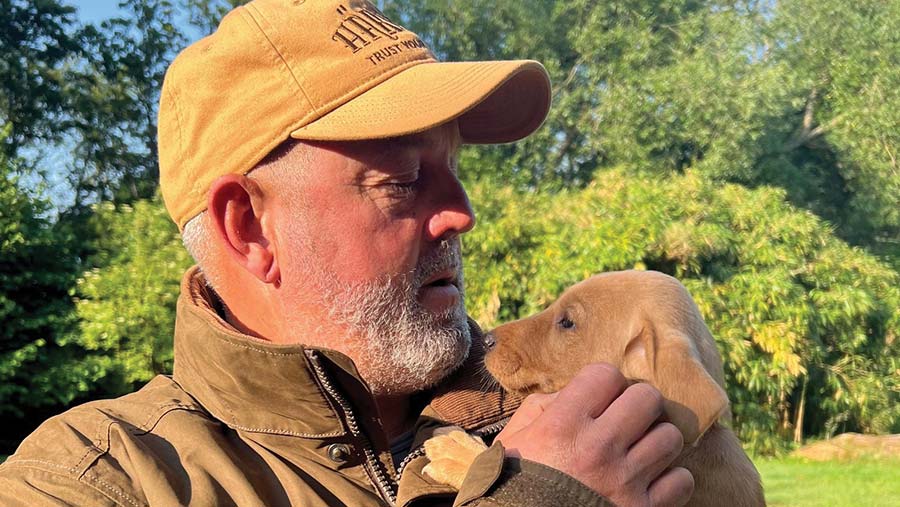How to train a gundog: Expert shares top tips
 © Jason Mayhew
© Jason Mayhew Gundogs have been the loyal companions of country folk for centuries, and the return of the annual Game Fair, the country’s longest standing and most prolific countryside celebration, means there is no more opportune moment to focus on our four-legged friends.
The training of gundogs, aside from being a rewarding discipline and a show of the bond between dog and owner, is also an opportunity to connect people with the field-to-fork journey and the world of game.
Former firefighter turned gundog trainer Jason Mayhew is passionate about the connections that gundogs have in the rural economy.
See also: Gun owners urged to respond to major firearms consultation
Based on the Cowdray estate in West Sussex, he takes pups, and their owners, from the early stages of basic training, all the way through to their first shoot days.
There is currently an 18-month waiting list to train with Jason, but Farmers Weekly managed to catch up with him before he heads to the Game Fair to get his top tips for training a young gundog.
Owner education
When training gundogs and working alongside their owners, Jason says that one of the greatest benefits is seeing the transformation in his clients in the way they become more educated about the countryside.
“Gundog training is really a way of reconnecting people with the countryside,” says Jason.
“A lot of the training is actually a country education.
“On the estate, people ask about the crops and the trees, and we are able to teach them about the field-to-fork journey, explaining why we don’t want crushed [training] dummies from a gundog because we want that bird to be ready for the plate.
“It is an opportunity for people to understand what got that bird onto a plate.
“There’s the gamekeeper, a rearer, a gun that has paid for it, the land that has been used, and the gundog that has gone out and been trained, and all of those cottage industries that support the rural economy and allow us to have a rural community.”
Choosing a pup
When it comes to choosing a puppy, Jason says the first thing prospective owners must do is establish what they want to achieve with the dog.
“If you want to go beating, then you will get a beating dog, such as a cocker spaniel,” he says.
“If you need a dog to go retrieving and picking up, then you would get a Labrador or something from the retriever breeds. Once you’ve made that decision, then you have to go about getting one that is health tested and doesn’t carry genetic diseases.”
Jason says that the Kennel Club website can be invaluable for finding good breeders, and the site’s tools allow you to search through health testing and lineage information for the puppy’s parents.
“We don’t want things like dwarfism or bad eyes, and we don’t want bad hip and elbow scores.
“You need all the health checks possible so that the puppy you buy has a higher probability that it is going to be in good health,” says Jason.
“For a dog to be Kennel Club registered means that you can look back through the parentage and see if there are any back generations that carry any genetic problems such as EIC [exercise induced collapse].
“I would always recommend someone to go to an assured breeder and do their checks via the Kennel Club.
“I would also be hesitant to pick a puppy at anything less than six weeks old. I want to see their attitudes, and this only starts to develop at around six weeks. If you can, I would hold back until then.”
Don’t over-train
One of the most common problems that Jason sees is young dogs that have been over trained at too young an age. “It is especially common in first-time owners,” says Jason.
“Many over-train their dogs and they become too keen or too bored. Don’t fall into the trap of training them too early.
“I don’t touch my dogs until they’re six or seven months old, and the lead goes on for the first time at six months old.”
Focus instead on establishing basic commands such as sit, heel, and recall, advises Jason.
The first few months are about creating a bond with the dog and allowing them to behave naturally and discover the world. “We put too much pressure on them,” he says.
“You’re better off letting the dog be a dog, and starting slowly with getting them to follow you round the garden, because that’s their natural instinct, and really build that partnership.
“Spend the time doing a little bit of sit, recall and heel work, but nothing formal.
“The biggest mistake that people make is showing what their dogs can do at eight months, but by the time it’s 18 months, the dog is wild and they’ve blown it’s mind.
3 key steps
“It’s always the jockey, and never the horse,” jokes Jason, who often finds that owners can unwittingly be giving their dogs confusing signals.
“We complicate the language when we communicate with dogs. We might be trying to do a whistle and a voice command, but our bodies are saying something else.
“Our dogs read us massively through body language, so we have to be careful not to give mixed messages.
“When I teach left, right and back, I tell people to imagine they are waltzing with a dance partner.
“If you want the dog to go back, you step in, as you would step your partner back. The same applies to teaching left and right.”
Jason’s top advice to owners training a gundog is to follow the Kiss (keep it simple, stupid) format, and not to overcomplicate exercises.
He breaks it down into three key things to remember:
- Look for the smallest try with the dog. This means the smallest effort, the smallest learning curve, that the dog gives you. Work with this, and manipulate it and keep going, and before long you’ll get what you want.
- Always think about what you can do to help your dog. This could be making it more simple by using white training dummies instead of green ones, or breaking down exercises by using footpaths.
- The final step is always consolidation. Once you think you have established what it is you’re trying to teach, test it and investigate it, and make sure it’s consolidated before you move on.
Gun licensing consultation
Chris Philp, minister for crime and policing, has launched an eight-week consultation looking into firearms and shotgun licensing, in a move that has been branded by rural sports organisations as the most significant in more than three decades.
Key recommendations made by the minister include the mandatory involvement of GPs in approving licence applications, and a review of the length of firearms certificates.
The British Association for Shooting and Conservation (Basc) has welcomed the consultation, and has urged members to respond so that the voice of the shooting community is represented in the decisions that will have an impact in the years, if not decades, to come.
Basc director of firearms Bill Harriman says: “This is the most significant and important firearms licensing consultation in 35 years. It is essential that the shooting community responds and feeds in its views.
“People must not be silent and think others will do the work for them. The shooting community must respond in numbers. Make sure you have your say.”
Top gundog trainer Jason Mayhew will be giving demonstrations at this year’s Game Fair at Ragley Hall, Warwickshire, from 28-30 July. He will be situated in the main arena on Friday and Saturday along with chef James Martin.

